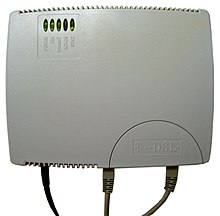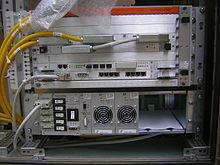Digital subscriber line
The bit rate of consumer ADSL services typically ranges from 256 kbit/s up to 25 Mbit/s, while the later VDSL+ technology delivers between 16 Mbit/s and 250 Mbit/s in the direction to the customer (downstream), with up to 40 Mbit/s upstream.In the 1950s, ordinary twisted-pair telephone cable often carried 4 MHz television signals between studios, suggesting that such lines would allow transmitting many megabits per second.One such circuit in the United Kingdom ran some 10 miles (16 km) between the BBC studios in Newcastle-upon-Tyne and the Pontop Pike transmitting station.Interleaved channel works better for file transfers, where the delivered data must be error-free but latency (time delay) incurred by the retransmission of error-containing packets is acceptable.All types of DSL employ highly complex digital signal processing algorithms to overcome the inherent limitations of the existing twisted pair wires.The commercial success of DSL and similar technologies largely reflects the advances made in electronics over the decades that have increased performance and reduced costs even while digging trenches in the ground for new cables (copper or fiber optic) remains expensive.These advantages made ADSL a better proposition for customers requiring Internet access than metered dial up, while also allowing voice calls to be received at the same time as a data connection.The subscriber's circuit is rewired to interface with hardware supplied by the ILEC which combines a DSL frequency and POTS signals on a single copper pair.These devices are installed indoors and serve the same purpose as DSL splitters, which are deployed outdoors: they divide the frequencies needed for ADSL and POTS phone calls.[13] By 2012, some carriers in the United States reported that DSL remote terminals with fiber backhaul were replacing older ADSL systems.The local loop was originally intended mostly for the transmission of speech, encompassing an audio frequency range of 300 to 3400 hertz (commercial bandwidth).However, as long-distance trunks were gradually converted from analog to digital operation, the idea of being able to pass data through the local loop (by using frequencies above the voiceband) took hold, ultimately leading to DSL.The local loop connecting the telephone exchange to most subscribers has the capability of carrying frequencies well beyond the 3400 Hz upper limit of POTS.DSL takes advantage of this unused bandwidth of the local loop by creating 4312.5 Hz wide channels starting between 10 and 100 kHz, depending on how the system is configured.Like analog modems, DSL transceivers constantly monitor the quality of each channel and will add or remove them from service depending on whether they are usable.Also, nonlinear elements in the phone could otherwise generate audible intermodulation and may impair the operation of the data modem in the absence of these low-pass filters.It is also commonly called an unbundled network element (UNE) in the United States; in Australia it is known as a unconditioned local loop (ULL);[16] in Belgium it is known as "raw copper" and in the UK it is known as Single Order GEA (SoGEA).At the exchange, a digital subscriber line access multiplexer (DSLAM) terminates the DSL circuits and aggregates them, where they are handed off to other networking transports.
DSL (disambiguation)Internet protocol suiteApplication layerHTTP/3ONC/RPCTelnetTLS/SSLTransport layerInternet layerLink layerTunnelsdigital datatelephone linesasymmetric digital subscriber lineInternet accessupstreamsymmetric digital subscriber linewired telephone servicefrequency bandsDSL filterbit ratekbit/sMbit/sdownstreamBell LabsNewcastle-upon-TynePontop Pike transmitting stationGaussian noisebroadbandIntegrated Services Digital NetworkISDN digital subscriber lineTelcordia Technologiesbasebandtwisted pairtelephone exchangesJoseph W. Lechleiderinterleaved channelstreaming multimediaBasic Rate Interfacehigh bit rate digital subscriber lineDigital Signal 1unshielded twisted-pairbandwidthADSL loop extenderslocal exchange carrierdigital signal processorsdigital signal processingvery-large-scale integrationdigital subscriber line access multiplexerDSL modemfiber-opticDOCSIS cable modemdry loopFederal Communications Commissionincumbent local exchange carriersunbundled network elementtelephone exchangebackhaullocal loopcommercial bandwidthtrunksanalog modemchannelsbondedtransceiverssubscriberInternet service providermodulationcarrier wavesplain old telephone serviceDSL filtersintermodulationlow-pass filtershigh-pass filtersloading coilfax machinesdial-up modemssubscriber linerouterEthernetpowerlinecommunicationClaude ShannonA Mathematical Theory of Communicationsymbol rateNaked DSLtelephonymobile telephonySpeakeasyVerizonattenuationlocal area networkterminateshanded offvoltagedemarcation pointtelephone outletsgatewaysAsynchronous Transfer ModebitstreambridgedroutedsubnetworkIP addressauthenticationMAC addresshostnamePoint-to-Point ProtocolDiscrete multitone modulationOrthogonal frequency-division multiplexingTrellis-coded pulse-amplitude modulationCarrierless amplitude phase modulationTwo-binary, one-quaternaryG.992.1G.992.3G.992.5Single-pair high-speed digital subscriber lineG.991.2Very-high-bit-rate digital subscriber lineG.993.1G.993.2High-bit-rate digital subscriber lineHigh-bit-rate digital subscriber line 2/4ANSI T1.413 Issue 2G.liteAsymmetric digital subscriber line 2




